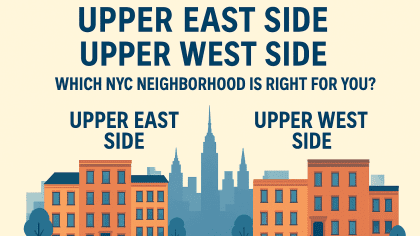Relocating to New York City is a thrilling adventure filled with opportunities and challenges. Whether you’re drawn by career prospects, cultural experiences, or the city’s unique energy, preparing adequately can make your transition smoother.
This comprehensive guide covers everything from choosing the right neighborhood to understanding the city’s climate, ensuring you’re well-equipped for your move.
Quick Summary
Relocation to New York City involves careful planning and adaptability. Key considerations include:
-
Neighborhood Selection: Choose based on lifestyle preferences and budget.
-
Cost Management: Be prepared for higher living expenses, especially in housing and utilities.
-
Transportation: Utilize the city’s extensive public transit system for efficient commuting.
-
Cultural Integration: Engage with the city’s diverse offerings to enrich your experience.
-
Social Connections: Proactively build a network to support your transition.
By addressing these areas, you can navigate the complexities of NYC and fully embrace the opportunities it offers.
Researching Neighborhoods
New York City comprises five boroughs: Manhattan, Brooklyn, Queens, The Bronx, and Staten Island. Each offers distinct lifestyles and amenities.
Manhattan
The city’s heart, known for its iconic skyline, bustling streets, and cultural landmarks. Neighborhoods like the Upper East Side and Tribeca offer luxury living, while areas like Harlem and Washington Heights provide more affordable options.
Brooklyn
A blend of historic charm and modern vibes. Brooklyn’s neighborhoods, like Williamsburg and DUMBO, are popular among young professionals, while Park Slope and Prospect Heights cater to families.
Queens
Known for its diversity, Queens offers a mix of urban and suburban living. Astoria and Long Island City are favorites for their proximity to Manhattan and vibrant communities.
The Bronx
Home to Yankee Stadium and the Bronx Zoo, this borough offers affordable housing and rich cultural experiences.
Staten Island
Offers a suburban feel with the convenience of a free ferry to Manhattan. Ideal for those seeking a quieter lifestyle.
Understanding the Cost of Living
New York City is renowned for its high living costs. Key expenses include:
-
Housing: Rent varies significantly by neighborhood. For instance, a one-bedroom apartment in Manhattan can range from $2,500 to $4,000 per month.
-
Utilities: Monthly costs for electricity, heating, cooling, water, and garbage average between $150 and $200.
-
Groceries and Dining: While dining out can be pricey, options like Trader Joe’s offer affordable grocery alternatives.
-
Transportation: A monthly MetroCard for unlimited subway and bus rides costs $127.
Finding Suitable Housing
Securing housing in NYC requires diligence:
-
Start Early: Begin your search at least a month in advance.
-
Use Reputable Platforms: Websites like StreetEasy and Zillow list available rentals.
-
Understand Lease Terms: Be aware of lease durations, renewal clauses, and any associated fees.
-
Consider Roommates: Sharing an apartment can significantly reduce costs.
Navigating Public Transportation
The Metropolitan Transportation Authority (MTA) operates NYC’s extensive transit system:
-
Subways and Buses: Cover all five boroughs, with 24/7 service on most lines.
-
Ferries: Offer scenic routes, especially the Staten Island Ferry, which is free.
-
Biking: Citi Bike provides a convenient bike-sharing option throughout the city.
Familiarize yourself with the MTA’s official app for real-time updates and route planning.
Settling Up Utilities and Services
Upon securing housing:
-
Electricity and Gas: Contact Con Edison to set up accounts.
-
Internet and Cable: Providers like Spectrum and Verizon offer various packages.
-
Water and Trash: Typically included in rent, but confirm with your landlord.
Ensure all services are scheduled to commence by your move-in date.
Embracing New York Culture
NYC’s cultural landscape is vast:
-
Arts and Entertainment: From Broadway shows to local art galleries, there’s always something happening.
-
Cuisine: Explore diverse culinary offerings, from street food to Michelin-starred restaurants.
-
Community Events: Participate in local festivals and neighborhood gatherings to immerse yourself in the city’s culture.
Building a Social Network
Establishing connections can ease your transition:
-
Join Local Groups: Platforms like Meetup offer events based on interests.
-
Attend Community Events: Engage in neighborhood activities to meet residents.
-
Volunteer: Contributing to local causes can introduce you to like-minded individuals.
Job Hunting Tips
Navigating NYC’s competitive job market:
-
Update Your Resume: Tailor it to highlight relevant experiences.
-
Leverage Networking: Attend industry events and utilize platforms like LinkedIn.
-
Consider Recruiters: Specialized agencies can assist in finding suitable positions.
-
Stay Persistent: The city’s dynamic job market requires resilience and adaptability.
Weather Preparation
NYC experiences four distinct seasons:
-
Winter: Temperatures can drop below freezing. Invest in a quality coat and waterproof boots.
-
Summer: Hot and humid, with temperatures often exceeding 85°F (29°C).
-
Spring and Fall: Mild and pleasant, ideal for outdoor activities.
Prepare your wardrobe accordingly to stay comfortable year-round.
Exploring Local Amenities
Familiarize yourself with neighborhood offerings:
-
Grocery Stores: Identify nearby supermarkets for daily needs.
-
Healthcare Facilities: Locate the nearest clinics and hospitals.
-
Recreational Areas: Discover parks, gyms, and entertainment venues.
Understanding your local amenities enhances daily living and convenience.





